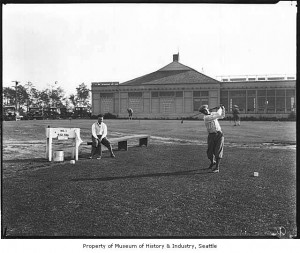By Heidi Madden & Chris Jacobsen

August 22, 1956 was the day the housewives of Crown Hill had been waiting for: The Plaza Shopping Center (a.k.a. Art’s Plaza) on 6th Ave. N.W. and Holman Road was having its grand opening. High on its tower, the iconic Art’s globe was spinning and there were gifts for everyone: fold-up plastic rain bonnets for the ladies, keychain screwdrivers for the men, and balloons for the kiddies.
The new 40,000-square-foot shopping center featured an Art’s Food Center, a Marketime Drugs, the Fiesta Buffet, Noonan’s Apparel, and a post office all under one roof. The massive shopping center was the brainchild of F.R. “Dick†McAbee, the prolific contractor whose scores of construction projects completed in the mid-1900s still have an impact on Crown Hill’s character, identity, and appearance.
The centerpiece of the development was the locally owned Art’s Food Center. Designed to appeal to the modern shopper, it featured a computerized meat scale, moving belts at the checkout stand, wide aisles, and 140 feet of frozen food cases housing the largest frozen food selection in the city.
The new Crown Hill location was the fourth grocery store for owner Art Case. Case may have been drawn to modern innovations, but he never lost sight of the value of his employees. He offered them respect and an attractive profit sharing plan, and most stayed with him for years.
Continue reading How a Grocery Store Shaped a Neighborhood: The Story of Art’s Food Center




